Want to purchase the best metal detector under $1000?
You have two choices.
First, if you have enough time, interview 10 metal-detecting enthusiasts, speak to 5 gold prospectors and consult innumerable online reviews. Then, once you’ve prepared a list of potential options, compare their discrimination, ground balance, sensitivity, volume controls, and pinpointing. Then you’d have enough knowledge to get the best metal detector for yourself.
Did you say you don’t have enough time?
Well, in that case, choose the second route which consists of merely scrolling down. Yup, just so you don’t have to, we adopted the first choice. Now all you have to do is to select the detector which fits the bill for you.
Contents
- 1 Best Metal Detector Under $1000 – Comparison Table
- 2 Garrett AT Pro – Best Waterproof Metal Detector
- 3 Teknetics Delta 4000 – Best Metal Detector Under $300
- 4 Bounty Hunter Quick Draw Pro – Best Budget Metal Detector
- 5 URCERI GC-1069 Metal Detector – Best Metal Detector Under $100
- 6 Fisher F22 – Best Metal Detector for Beginners
- 7 Garrett Ace 300 Metal Detector – Best Metal Detector for the Money
- 8 Fisher Gemini-3 – Best Metal Detector Under $800
- 9 National Geographic PRO Series – Best Metal Detector Under $200
- 10 Garrett AT MAX – Best Metal Detector Under $1000
- 11 Makro Gold Racer – Best Metal Detector Under $700
- 11.1 Features You Cannot Afford To Miss
- 11.2 Metal Detector FAQs
- 11.2.1 How much should be the detection depth of my detector?
- 11.2.2 DD or Concentric Coil: Which is the best?
- 11.2.3 Difference between Water-resistant and Waterproof Searchcoil?
- 11.2.4 Is Manual Ground Balance better than Automatic?
- 11.2.5 How to Use the Pinpointer Feature?
- 11.2.6 How deep will my metal detector go?
- 11.2.7 Why Should I use Headphones with my detector?
- 11.2.8 Ni-Cadmium or Alkaline: Which Batteries are better?
Best Metal Detector Under $1000 – Comparison Table
| Weight | Depth | Waterproof Coil | Price | |
|---|---|---|---|---|
| Garrett AT Pro | 3.03 pounds | 10’’ + | Yes | |
| Teknetics Delta 4000 | 5.35 pounds | N/A | Yes | |
| Bounty Hunter Quick Draw Pro | 2.4 pounds. | 10’’ | Yes | |
| Urceri GC-1069 | 5.95 lbs. | N/A | Yes | |
| Fisher F22 | 2.3 pounds | 9’’ | No | |
| Garrett Ace 300 | 5.45 pounds | 12’’ | Yes | |
| Fisher Gemini-3 | 5 pounds | 20’ | N/A | |
| National Geographic Pro Series | 2 pounds | 10’’ | Yes | |
| Garrett AT Max | 3.03 pounds | 10’ | Yes | |
| Makro Gold Racer | 3 pounds | N/A | Yes |
Garrett AT Pro – Best Waterproof Metal Detector
Features
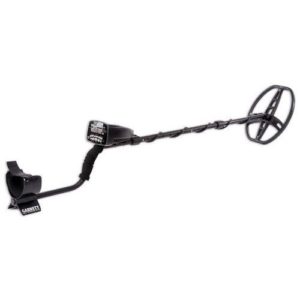
Ask expert treasure hunters, and they might tell that not every gold bullion in this world exists under solid ground. Sometimes, you’ve to take a dip in water to discover the unadulterated wealth lying there. Therefore, if you want to search a treasure underwater, the Garrett AT Pro would certainly help.
Starting from the best this detector has to offer, and its under-water performance deserves a mention. It allows full water submersion and can go 10 feet deep underwater, with all its functions still performing at their best. It displays similarly impressive results whether you use it off-shore or over reefs.
Then there’s the Target ID feature of this model which tells you how close (or away) you’re from your target. It does the same by displaying numbers between 0 and 100, with numbers close to 100 suggesting that you’re close to hitting the jackpot.
By offering two search modes – Professional and Standard – the AT Pro further refines your research. Activate the former if you’re looking for gold nuggets, whereas the latter is recommended for searching gold coins. Both have different tones to identify different sets of targets.
To increase the detection depth of this model and cut down the occurrence of false signals, the AT Pro offers both manual and automatic ground balance. If you’re a veteran in the field, only then turn to the former ground balance. Otherwise, make full use of the ease of the automatic option.
Finally, turning our attention to what comes in the box of AT Pro, and apart from the search coil, instruction manual, and instruction DVD, it provides land headphones and a two-year warranty card.
|
PROS
|
CONS
|
|
|
Teknetics Delta 4000 – Best Metal Detector Under $300
If there’s one thing most metal detectors aren’t known for, that has to be accuracy. Luckily, however, the Teknetics Delta 4000 bucks the trend by being one of the most accurate metal detectors in this review.
Features
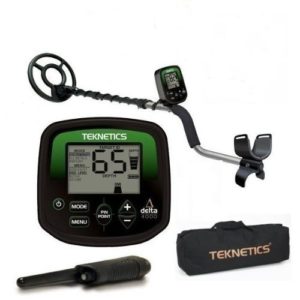
The Teknetics Delta 4000 has an 11-inch searchcoil which gives it a detecting depth of around 1-foot. Its screen shows a large target ID number while you’re scanning which tells you the metal you’ve found. To give you an even better idea of the type of treasure, a tab lights up on one corner of the screen. It differentiates between iron, a silver dollar, a quarter and so on.
That means you don’t have to memorize which target ID number corresponds to which metal. Still, if you need little help, a handy compact chart is provided in the instruction manual. This chart contains a description of each target ID number so that you know which target ID relates to which metal.
Also present on the LCD display is a ‘’Mode’’ button. Press it, and you’d be asked to choose between the Discriminate and All Metals Mode. Each mode has its own adjustable sensitivity settings. The right corner of the screen shows a depth bar where signals will tell you how close (or far) you’re from the target.
Located in the middle of the screen is a ‘’Pinpointer’’ button which narrows down the target area for you. All you have to do to use it is to press the button, and first perform a side-to-side sweep and then a back-to-front one. The point where the pinpointer beeps the loudest should be where you start digging.
Finally, the Delta 4000 features three different tones (low, medium, and high) to let you know whether you’ve hit a trash or treasure. Six levels of discrimination and an additional Notching feature are also on offer.
The only complaint users have about this model is its price tag. They feel that even with all the features that it provides, this model is expensive.
|
PROS
|
CONS
|
|
|
The Teknetics Delta 4000 Metal Detector has got all the features which interest serious treasure hunters. If you think you’re one, go for this model.
Bounty Hunter Quick Draw Pro – Best Budget Metal Detector
Despite being intuitive and accurate, the Bounty Hunter Quick Draw Pro costs less than most metal detectors on the market. That said, the fact that it’s accurate doesn’t mean that the Quick Draw Pro offers the best detecting range on the market.
Features

The heart of the Quick Draw Pro is its 10-inch concentric search coil which is known for its accuracy. Capable of tracking objects up to 9’’ below the ground, this coil is waterproof and you could also adjust its length for easy storage.
To save you both time and effort, this detector offers notching and discrimination capabilities. It means you can restrict your search to a certain type of metals. Then there is the graphic target depth indicator which showcases the depth of the buried object.
Before that, you could take help from the pinpoint mode to know where to start digging. Afterward, you can take advantage of the target ID feature to know more about the object while it is still buried under layers of ground.
What’s more, the Quick Draw Pro also lets you adjust its volume, which is a feature you normally don’t expect from detectors in this price spectrum. A 3 tone audio ID, which tells you whether the object is buried deep or shallow, is also provided in the package.
Finally, the detector provides you with 10 sensitivity adjustment levels. If your detector is giving you false readings, simply turn its sensitivity down. Conversely, if it isn’t picking up anything, amp-up its sensitivity to turn your search into a fruitful one.
The only problem most users have with this model is the fact that the screen of this model isn’t backlit. It means that while it will do its job perfectly in daylight, you’d need to direct a torch on the screen to see anything at night.
|
PROS
|
CONS
|
|
|
URCERI GC-1069 Metal Detector – Best Metal Detector Under $100
Who says only kids’ metal detectors are inexpensive? The Urceri GC-1069, despite its dirt-cheap price tag, provides a myriad of features including a waterproof coil and various search modes.
Features

Even before you start using it, the GC-1069 will impress you with the number and quality of accessories in its package. For, in addition to the metal detector, its package contains a shovel, a pair of headphones, user manual, and a carrying bag.
Moving on, the GC-1069 has an 8.7’’ search coil which is completely submersible in water and which has a detecting depth of around 6’’. The detector, meanwhile, offers four sensitivity levels with the lowest tracking only valuable items and the highest tracking every piece of metal.
The screen of the GC-1069 contains three buttons: two of which are dedicated to increase/decrease its volume and the third to let you choose between its modes. Yes, it’s right, despite its low price tag, the GC-1069 provides two search modes including the All Metal Mode and Discrimination Mode.
While the screen has a low button count, it is rich in real-time information. It displays information including sensitivity level, depth, battery level, and low battery indicators as you’re on your searching expedition. It also shows the relative depth at which the target could be found and also provides the target location function.
Finally, while the battery timing of this detector is already impressive, you can improve it further by connecting it with a headphone, which is provided in the package. There are three volume levels, too, to let you set your preference.
|
PROS
|
CONS
|
|
|
Fisher F22 – Best Metal Detector for Beginners
The Fisher F22 Metal Detector is a worthy addition to the already impressive collection of Fisher Metal Detectors. It might be a great choice for anybody new to the detecting hobby.
Features
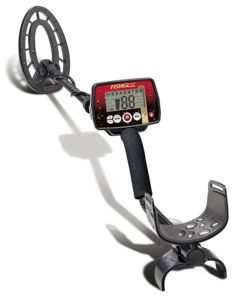
First thing first, the Fisher F22 has a pretty exhaustive list of the things it could do, and the features it offers. Take, for instance, its search coil which has a detection depth of 9’’. Or the fact that it provides 10 adjustable sensitivity levels. Or the 2 digit Target ID feature which tells you in advance the type of metal that exists underground.
The best feature which the F22 has to offer is a pinpointer. Once you activate this feature and pass the detector over an area, the pinpointer would identify the exact spot under which the target lay buried. Afterward, as you dig and the distance between the detector and the target decreases, the pinpointer oozes a loud beep to tell you that you’re going the right way.
It also offers four search modes, which is the biggest number of search modes which any detector in this review has to offer. They include an artifact mode to search steel stakes, a relic mode to detect gold and silver, a coin mode to increase the detecting speed, and the above-mentioned pinpoint mode.
Thanks to the two AA batteries which charge this device, the F22 will last more than 15-hours on the same set of batteries. The device comes with an impressive 5-year warranty and also lets you adjust the volume of its beeping.
Its screen, meanwhile, displays the depth of the target via three notches. Three notches mean the object is 6’’ below the ground, two notches mean it’s less than 6’’, and one notch means your target is lying 3’’ underground.
|
PROS
|
CONS
|
|
|
Garrett Ace 300 Metal Detector – Best Metal Detector for the Money
The Garrett Ace 300 is a formidable metal detector despite the fact it weighs over 5 pounds, which means it is heavier than most other detectors in this review. So, only go for this option if its weight doesn’t bother you.
Features
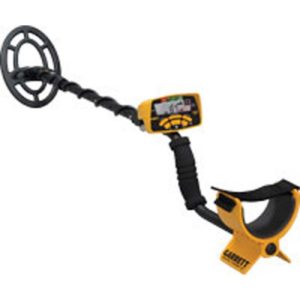
The Garrett Ace 300 features both the Digital Target ID as well as the segment-based discrimination system. The former is a numerical scale which ranges between 0-99 and indicates the conductivity of the buried object, with higher numbers suggesting higher conductivity.
It means that while you’ll get metals like silver – which have high conductivity – in the 90s, low-value targets including iron will appear between 0-30. Gold and aluminum, both of which are mid-conductivity metals, will appear between the 40 and 60 range.
Moving on, while it is not as important as the Digital Target ID, some users might find its adjustable frequency equally useful. For, while its preset frequency is 8kHz, you can tinker it slightly to counter interference from nearby power lines or Wi-Fi signals.
More importantly, the Garrett Ace 300 provides five search modes. They include zero, jewelry, custom, relics, and coins. All these search modes work by eliminating everything above and below their search range so that you can narrow down your search.
Other notable features of this model include the 3 Audio Tone ID Levels for additional target differentiation. There are also 8 sensitivity adjustment levels to avoid false signals and a depth indicator to let you know how deep you need to dig. Also present is an electronic pinpointer which zeroes in on the target.
|
PROS
|
CONS
|
|
|
Fisher Gemini-3 – Best Metal Detector Under $800
The Fisher Gemini 3, due to its 16 AA batteries, digs deeper, traces farther, and runs longer than any other detector in this review. So, if you can afford it, this metal won’t leave you wanting.
Features

The fact that it relies on a two-box design provides this metal detector with two unique benefits. First, it can dig as deep as 20ft. Second, the two-box design also makes this detector more accurate than any other in this review.
Guess what, despite providing such mammoth range, the utility of the Gemini 3 isn’t only limited to professionals. Instead, since most of the settings of this device come pre-set, anybody with even a minor interest in the field could find it useful.
However, that doesn’t mean that adjustability is not on offer in this model. Rather, in addition to adjustable volume, it allows you to adjust its sensitivity and choose from a wide cache of search modes. Also, a pinpointing feature is also on offer.
To let you adjust the sensitivity of this device, it provides a large knob potentiometer on its control panel. Also included is a ‘’check battery’’ button pressing which you can check the remaining power of this model. And to make sure you don’t get disheartened by looking at its astronomical price tag, a 5-year warranty is provided in the package.
|
PROS
|
CONS
|
|
|
National Geographic PRO Series – Best Metal Detector Under $200
Thanks to its competitive price, a large number of treasure hunters could afford the National Geographic Pro Series. However, it won’t be wrong to suggest that some cost-cutting measures were employed to bring down the price of this device.
Features
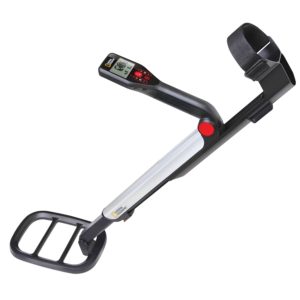
First thing first, you don’t need to assemble the Pro Series since it comes pre-assembled. Yes, it comes fully assembled and while the detector measures 51’’ when fully extended, it is collapsible up to 22’’ for easy storage. Its 11’’ coil, meanwhile, is fully waterproof and the weight of the whole unit is a mere 1kg.
Moving on, the Pro Series takes a lead on most other detectors in this review by offering three search modes in the package. You can choose between an ‘’All Metal’’ mode or you could turn to the ‘’All Metals other than Iron’’ one. And if you think both of them aren’t useful, the ‘’All Metals other than Iron or Aluminum’’ mode will sort you out.
Fixating our attention on its control panel, and all you’d see is a plethora of useful buttons. For instance, while one button lets you activate the pinpoint feature, other lets you order the detector to discriminate. There are others which allow for adjusting volume, sensitivity, and modes of this device.
Finally, you get a backlit screen with this model to search in low-light conditions. The screen, on its own, is pretty useful as it shows the remaining battery life, depth of the target, and contains four icons to predict the type of object buried underneath the ground.
|
PROS
|
CONS
|
|
|
Garrett AT MAX – Best Metal Detector Under $1000
For those of you who have a keen interest in gold prospecting, the Garrett AT Max is certainly worthy of your attention.
Features
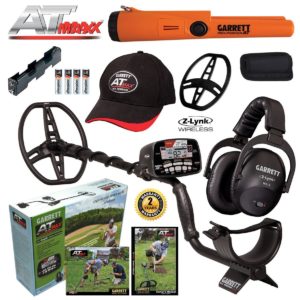
The Garrett AT Max won’t pose the signal interference problem which mars the performance of many detectors. That is, because, it relies on a Z-Lynk Wireless Technology which is six times faster than Bluetooth and transmits audio directly to the headphones.
Also, this metal detector boasts backlit LCD screen to allow you to use the detector in low-light conditions. The control panel containing the screen has 11 buttons, all of which increase the utility of this metal detector.
What’s more, it has a ‘’Frequency Adjust/Sensitivity’’ button to let you decide the type of targets it should detect. Then there is the ‘’Iron Disc/Notch Disc’’ button which narrows down the search range for this device. And while a ‘’Manual Ground’’ button is present as well, you can still rely on the preset ground balance of this device.
Finally, you get four search modes in this device. They include a Custom Mode which lets you fine-tune the device at will. A True Metal mode is also present to detect iron, and a Coins Mode is available to discover old relics. And if you’re having a bad day – which means you aren’t able to get any hits – you can activate the Zero discrimination mode to let the detector target every conductive metal in its range.
|
PROS
|
CONS
|
|
|
Makro Gold Racer – Best Metal Detector Under $700
Even for a diverse community of treasure hunters – which rarely, if ever, agree on the same thing – the Makro brand name doesn’t divide opinions. For, all veteran hunters know that Makro is a reputed brand name when it comes to churning out detectors.
Features
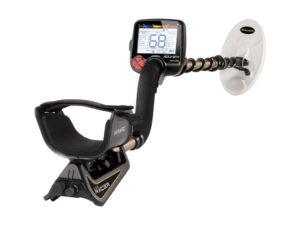
The Makro Gold Racer is as intolerant when it comes to allowing outside signal interference as the abovementioned Garrett AT Max. However, while the AT Max relies on Z-Lynk wireless technology to take care of outer signals, the Gold Racer gets the same result by running on 56KHz frequency.
Also, while it doesn’t feature the traditional pinpointing feature, the Gold Racer presents two better features in its place. For, it uses cutting-edge features including iSAT (Intelligent Self-Adjusting Threshold) and iMask (Intelligent Masking) features to avoid disruption in highly mineralized areas.
An audio boost feature is also on offer. Provided you activate it, this feature would increase the level of the detector’s beep every time it hits a target. A tone break feature, which lets the detector distinguish between trash and treasure, is also on offer.
Lastly, you get three search modes with this device, the first of which offers no discrimination whatsoever. The other two, titled DISC 1 and DISC 2, progressive increase the discrimination level of the device to ensure it zeroes in only on useful targets.
|
PROS
|
CONS
|
|
|
Features You Cannot Afford To Miss
However, regardless of how you operate this feature, it works the same in every detector containing it. And it works by discrimination between jackpots and junks. As a result, the detector would produce fewer beeps and save more time for you to focus on the target.
Detectors containing the ground balance feature provide one of its three forms. They either provide manual ground balance – where you’ve to manually adjust the ground balance – or automatic ground balance – where the ground balance comes preset.
Then there are detectors whose price is close to $1000 and which provide tracking ground balance. Such ground balance adjusts itself while you’re detecting. Needless to say that it is the most accurate type of ground balance.
Like the ground balance feature, there are two major types of pinpointer: the ones which come built-in in the detector and the others which are sold separately. Unless you do detecting for a living, we recommend sticking with the built-in pinpointer feature.
Find the difference confusing? Let’s clear things out with an example. Imagine that you want your detector to ignore pull-tabs while detecting but want it to present everything below and above those pull-tabs in its final results. That is where notching, and NOT discrimination, will come to your rescue.
However, if you have rotated its sensitivity knob to the extreme right – which means you’ve increased its sensitivity – the detector will only beep when it detects precious objects.
Some detectors present the target ID in a numerical form where its value ranges between 0 – 99. To let you know the meaning of each number, you’ve to consult the instruction manual which comes in the detector’s package.
Still, there are other detectors who provide graphic target ID. Although they are in the minority, graphical target ID providing detectors save you from the nuisance of cramming the conductivity ranges to know the meaning of each number.
Metal Detector FAQs
When purchasing a metal detector, most people have numerous questions in their mind which the salesperson is unable to answer. In this section, we’re going to answer some of those.
How much should be the detection depth of my detector?
For those who don’t know it, detection depth means the range underneath the ground where the detector would spread its signals in an effort to locate precious objects. Coming back to the question, there’s no ideal detection depth.
Instead, it depends on what you want to detect and where you are going to detect it. For instance, if you want to search gold, your detector should at least have a detection depth of 11’’. Conversely, if you’re a hobbyist, anything above 6’’ of detection depth is enough for you.
DD or Concentric Coil: Which is the best?
That part of the detector which creates a magnetic field which, in turn, helps locate buried objects is known as its coil or search coil. Fortunately, unlike the above-mentioned detection depth whose suitability varies with the user, the concentric coil is the best for everyone.
That is, because, the concentric coil allows the detector to discriminate. As a result, detectors having concentric coils produce less false signals and are therefore more accurate. That is exactly the reason why almost all the high-end detectors employ concentric coil.
Difference between Water-resistant and Waterproof Searchcoil?
Water-resistant search coils are those which you can employ in shallow water. You may not take them to the beach, but they could withstand small, erratic bursts of water. Waterproof search coils, however, are submersible in water up to a certain depth.
That said, whether your detector has a waterproof or water-resistant search coil, NEVER completely submerge them in water. For, while the coil may be waterproof, the control panel of most detectors isn’t. And since it contains electric parts, the control panel might be destroyed if you expose it to water.
Is Manual Ground Balance better than Automatic?
No, manual ground balance is NOT better than its automatic counterpart. That is, because, there’s always the element of a human error in manual ground balance. And if you aren’t an expert, there’s a good chance that manually adjusting the ground balance will have more bad effects than good.
Therefore, if you’re a novice in this field – or even a veteran who doesn’t want to take any chance, make sure you get a detector which offers automatic or preset ground balance.
How to Use the Pinpointer Feature?
Most metal detectors come with instruction manuals which tell you to “X” the target after the detector has pinpointed it. You can do it by first performing a side-to-side sweep and then a front-to-back one.
Perform those sweeps numerous times, and record the spot where the signal of the signal of the pinpointer feature was the strongest. Mark an ‘’X” symbol on this spot and start digging.
How deep will my metal detector go?
The answer to this question depends on several variables, the first of which is the conductive properties of the soil on which you’re detecting. If this soil is highly mineralized, the detection depth of the detector will suffer. Conversely, if it’s clean of minerals, your detector will be able to go deep.
The size and shape of the object also affect the detection depth. Large-sized objects can be located even if they are buried than small-sized targets which have to be buried close to the ground for the detector to detect them.
Finally, the length of time for which the object is buried will also impact the detection depth. Objects which are non-corrosive, like gold, aren’t affected by this. However, others like copper and silver, which are highly prone to rust, won’t be easy to detect once some time has passed.
Why Should I use Headphones with my detector?
Good quality headphones, by reducing outside noise (wind, traffic, waves), enhance the quality of the audio target signal. In this way, you are better able to decide which target to dig and which to overlook.
Also, headphones increase the battery life of your detector because they draw less current to operate than the low impedance speaker of the detector. Finally, good headphones – by letting you hear even the faintest of signals – increase the number of your good finds.
Ni-Cadmium or Alkaline: Which Batteries are better?
It depends on how you intend to use your detector. For example, Ni-cadmium batteries are rechargeable whereas the Alkaline batteries are disposable. However, while Ni-Cad batteries last between 8 to 12 hours on a full charge, Alkaline batteries are known to last between 24 and 30 hours.
Also, while the cost of Ni-Cad batteries is up to $10 each, you can get an Alkaline battery for as less as $2.
Still, if you feel we missed something, please let us know using the below-mentioned comments box.

